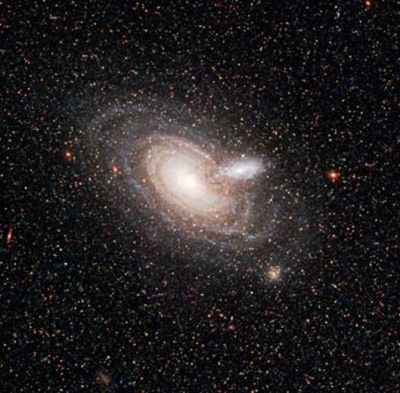17 September 2008

Credit: NASA, ESA, and The Hubble Heritage Team (STScI/AURA)
NASA's Hubble Space Telescope (HST) has captured a rare alignment between two spiral galaxies. The outer rim of a small, foreground galaxy is visible in silhouette, in front of a larger background galaxy.
The larger background galaxy is similar in size to our Galaxy, and is about 10 times larger than the foreground galaxy. The two galaxies are not in collision; they just happen to lie in our line of sight. The distance of the background galaxy has been estimated to be 780 million light-years. Astronomers have not as yet calculated the distance separating the two galaxies, although they think the two are relatively close, but not close enough to interact.
Interestingly, HST’s sharp vision has revealed previously unseen galactic features; skeletal tentacles of dust can be seen extending beyond the small galaxy's disk of starlight. Such outer dark dusty structures, which appear to be devoid of stars, like barren branches, are rarely conspicuous in a galaxy because there are usually no stars behind them to illuminate them. This is the first detection of dust this far beyond the visible edge of a galaxy. It is not known whether these dusty structures are common features in galaxies.
Determining a galaxy's color and how dust affects and dims that color are crucial to measuring a galaxy's true brightness. By knowing the true brightness, astronomers can compute the galaxy's distance from Earth.
Most of the stars scattered across this image belong to the nearby beautiful spiral galaxy NGC 253, which is out of view to the right. Astronomers used HST's Advanced Camera for Surveys to snap images of NGC 253, when they observed the two galaxies in the background. In the images of ground-based telescopes, the two galaxies look like a single blob. But the Advanced Camera's exquisite resolution distinguished the blob as two galaxies, designated as 2MASX J00482185-2507365. The images were taken on 19 September 2006.
Further Reading
Hubble Site
http://hubblesite.org/
Aymen Mohamed Ibrahem
Senior Astronomy Specialist